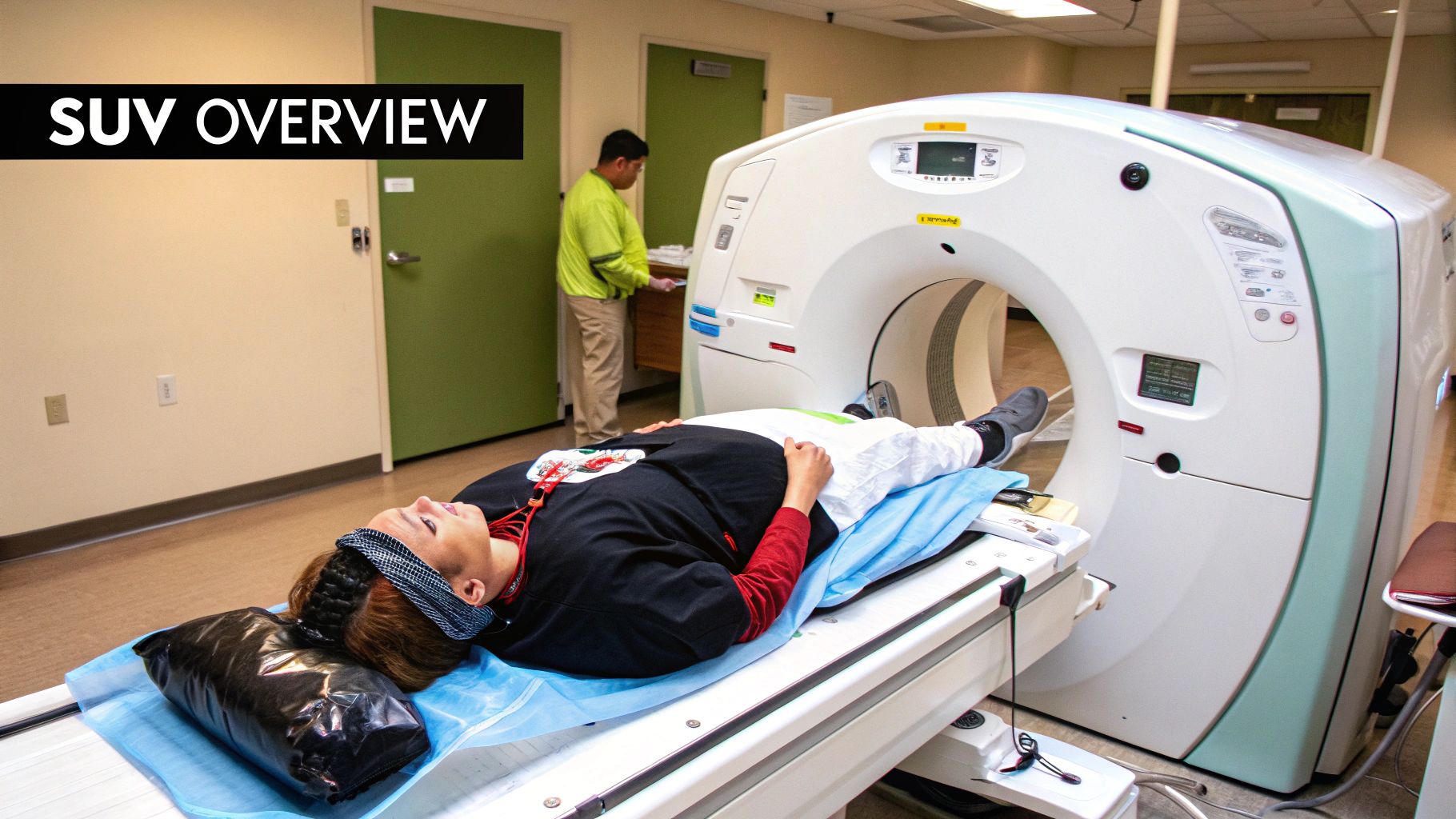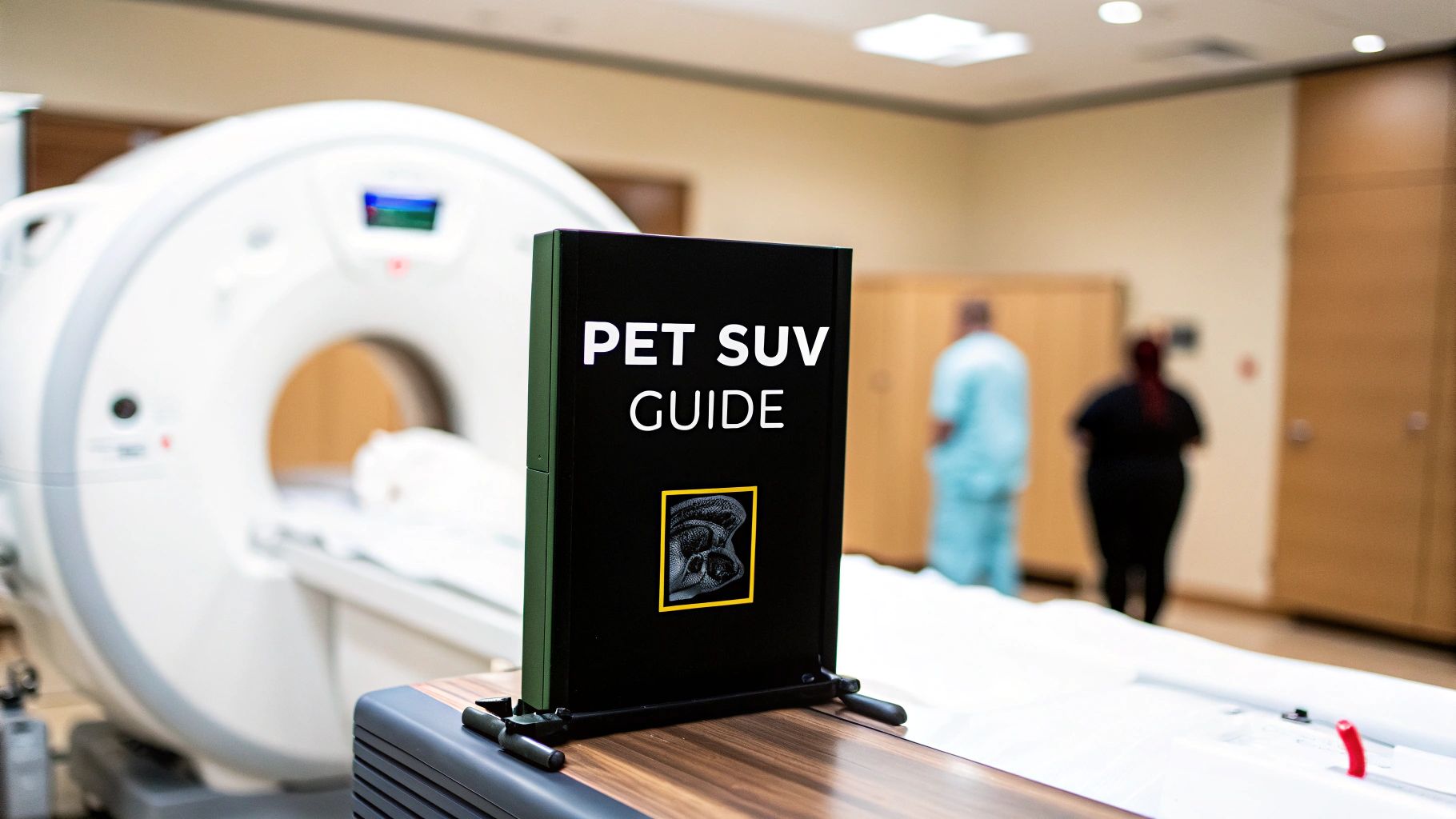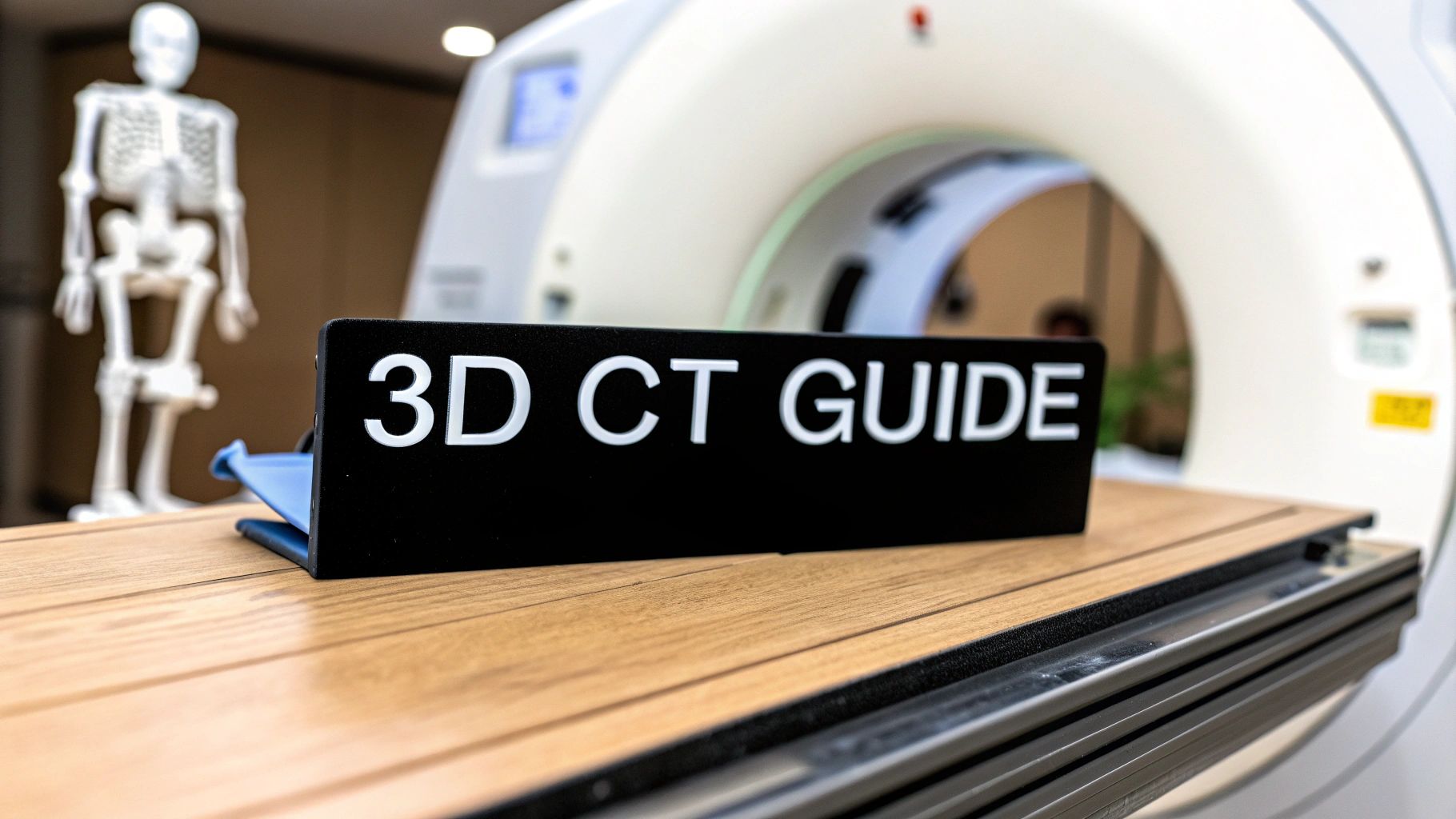Understanding Standardized Uptake Value Fundamentals

The standardized uptake value (SUV) is a key metric in positron emission tomography (PET) imaging. It's especially important in oncology, where it helps doctors distinguish between healthy and diseased tissues. The SUV quantifies the metabolic activity of tissues by measuring the concentration of a radiotracer.
The most common radiotracer used is fluorine-18 fluorodeoxyglucose (FDG). In essence, the SUV provides a standardized measurement of how much of the injected radiotracer accumulates in a specific area of the body. This quantification allows for more objective comparisons across different patients and imaging sessions.
The SUV concept emerged in the 1980s as PET imaging gained popularity, particularly in oncology. Its initial use was primarily with FDG. This provided a significantly more sensitive method for identifying tumors and quantifying metabolic activity compared to previous methods. Learn more about standardized uptake values. Healthcare professionals looking to improve their social media presence can find helpful tools like this healthcare content generator.
How Is SUV Calculated?
Several factors go into calculating the SUV. These include the injected dose of the radiotracer, the patient's weight, and the time elapsed between the injection and the imaging. A simple analogy is comparing it to measuring the sweetness of a drink. It's like measuring the sugar concentration (radiotracer) adjusted for the liquid volume (patient's weight) at a specific time after adding the sugar (injection).
This provides a standardized measure of sweetness (metabolic activity). However, keep in mind this is a simplified example. Actual SUV calculations are more complex.
Why Is SUV Important?
SUV is now a fundamental part of modern oncology for several reasons.
-
Tumor Detection and Characterization: It helps differentiate between benign and malignant lesions based on their metabolic activity.
-
Cancer Staging: SUV plays a vital role in determining the extent of the disease, which helps guide treatment planning.
-
Monitoring Treatment Response: Changes in SUV values over time can show whether a treatment is working, allowing for adjustments as needed.
-
Improved Prognosis: SUV provides valuable insights into the likely progression of the disease.
Understanding SUV fundamentals is crucial for anyone involved in diagnosing, treating, and managing cancer.
Decoding Different SUV Measurement Types

This infographic visually represents the factors involved in SUV calculation, highlighting the relationship between injected radiotracer dose and patient weight. The standardized uptake value (SUV) is derived from these inputs to provide a standardized measure of metabolic activity. This standardization is crucial for consistent interpretation and comparison of PET scan results.
Not all SUV measurements are the same. Understanding the different types—SUVmax, SUVmean, and SUVpeak—is essential for accurate clinical interpretation. These measurements provide different perspectives on tumor behavior. Choosing the right metric is vital for effective patient care.
SUVmax
SUVmax represents the maximum SUV within a region of interest (ROI). It's like pinpointing the brightest spot in a room. SUVmax is frequently used for initial diagnosis and staging due to its ease of measurement and high sensitivity to tumor activity. However, it can be influenced by image noise and partial volume effects, sometimes impacting reliability.
SUVmean
SUVmean is the average SUV within the ROI, reflecting the overall metabolic activity of the entire tumor region. This is particularly helpful for heterogeneous tumors with varying metabolic activity. Because it considers the entire tumor area, SUVmean is less susceptible to image noise than SUVmax. This makes it valuable for monitoring treatment response and assessing disease progression.
SUVpeak
SUVpeak offers a slightly different approach. It measures the average SUV within a smaller, fixed-size region within the tumor, usually a 1-cm3 sphere around the SUVmax. This method aims to minimize partial volume effects and is less sensitive to noise, improving reproducibility across different PET scans. SUVpeak is particularly beneficial when precise quantification is crucial, such as in clinical trials.
To further clarify the distinctions between these SUV measurements, let's examine a comparison table. The table below summarizes the key features, clinical uses, advantages, and limitations of each SUV type.
Comparison of SUV Measurement Types
| SUV Type | Definition | Clinical Use | Typical Range | Advantages | Limitations |
|---|---|---|---|---|---|
| SUVmax | Maximum SUV within an ROI | Initial diagnosis, staging, assessing treatment response | 2.5 – >20 (varies depending on tumor type) | Easy to measure, highly sensitive to tumor activity | Susceptible to image noise and partial volume effects |
| SUVmean | Average SUV within an ROI | Monitoring treatment response, assessing disease progression, characterizing heterogeneous tumors | Lower than SUVmax, but more representative of overall tumor metabolism | Less affected by noise than SUVmax | May not capture the most aggressive parts of a tumor |
| SUVpeak | Average SUV within a 1-cm3 sphere around SUVmax | Clinical trials, situations requiring high accuracy and reproducibility | Between SUVmax and SUVmean | Minimizes partial volume effects, less sensitive to noise | More computationally complex than SUVmax or SUVmean |
This table provides a concise overview of how SUVmax, SUVmean, and SUVpeak differ. By understanding these differences, clinicians can select the most appropriate SUV measurement for a given clinical scenario, leading to more accurate interpretations and better patient care.
Clinical Applications In Cancer Detection
The standardized uptake value (SUV) is a crucial metric in modern cancer care. It helps doctors detect, stage, and plan treatment by quantifying the metabolic activity of cells. Because cancerous cells often exhibit higher metabolic activity than benign cells, SUV allows oncologists to pinpoint potentially malignant lesions that other imaging methods might miss.
SUV Thresholds and Characteristic Patterns
Different types of cancer often display distinct SUV patterns. For instance, highly aggressive cancers tend to have higher SUV values, reflecting their rapid metabolic rates. This information helps oncologists diagnose the specific cancer type and tailor treatment strategies accordingly. Specific SUV thresholds can also help differentiate benign from malignant lesions. While these thresholds aren't definitive, they serve as a useful benchmark, especially when considered alongside other clinical findings.
SUV and Cancer Staging
Accurate cancer staging is paramount for effective treatment. SUV measurements play a vital role in this process, offering key insights into the extent and spread of the disease. This knowledge is essential for determining the most appropriate treatment approach, whether surgery, chemotherapy, radiation therapy, or a combination thereof.
The use of SUV has dramatically improved early cancer detection and monitoring. In major medical markets like the United States, Western Europe, and Japan, over 2 million PET scans utilizing FDG are performed annually, with SUV measurements now a standard part of the procedure. Learn more about this topic here. An international survey conducted in 2017 found that over 85% of oncologists in major cancer centers utilize SUV values to inform their treatment decisions.
Integrating SUV with Other Diagnostic Tools
SUV values are never considered in isolation. Oncologists integrate this data with other diagnostic tools, including biopsies, blood tests, and other imaging studies, to develop a complete understanding of each patient's individual case. This comprehensive approach results in more informed and personalized treatment plans.
Personalized Cancer Care
SUV measurements contribute to the advancement of personalized cancer care. By precisely measuring metabolic activity, oncologists can better predict how a patient might respond to various treatments. This allows for a more targeted and effective approach, maximizing therapeutic benefits while minimizing potential side effects, ultimately leading to improved patient outcomes.
Surgical Planning and Prognosis
SUV also plays a significant role in surgical planning. By accurately locating and characterizing tumors, surgeons can plan more effective procedures. This precision minimizes the risk of complications and increases the likelihood of complete tumor removal. Furthermore, SUV measurements help refine prognosis assessment. By monitoring changes in SUV over time, oncologists can track treatment response and adjust strategies as needed. This dynamic approach optimizes patient care and improves long-term outcomes.
Factors That Impact SUV Accuracy

The accuracy of standardized uptake value (SUV) measurements in PET imaging depends on several key factors. If not carefully managed, these factors can introduce variability and affect the reliability and clinical usefulness of SUV data. Understanding these factors is essential for anyone involved with PET imaging.
Patient Preparation and Imaging Timing
Consistent patient preparation is crucial for obtaining accurate SUV measurements. Factors such as blood glucose levels have a significant impact on how the body takes up FDG. High blood glucose can reduce tumor FDG uptake, resulting in lower SUV values. This is why fasting before a PET scan is so important for getting the best results.
The timing of the imaging after the radiotracer injection is also critical. SUV values change over time as the radiotracer is distributed throughout the body. Consistent uptake times are therefore needed to ensure accurate and comparable measurements.
Scanner Calibration and Reconstruction Algorithms
Scanner calibration plays a vital role in SUV accuracy. Regular quality control and calibration checks ensure that the scanner is working correctly and producing reliable data. The reconstruction algorithms used to process the PET data also affect SUV values.
Different algorithms can lead to slightly different SUV quantifications, even when using the same initial data. Using standardized reconstruction parameters is therefore important for comparing results across different studies.
Region of Interest (ROI) Selection
Precisely defining the region of interest (ROI) is crucial for accurate SUV measurements. The ROI specifies the area within the image where the SUV is calculated. Inconsistent or inaccurate ROI selection can introduce significant variability, especially for metrics like SUVmax.
This is particularly relevant for smaller lesions, where even small changes in ROI placement can greatly impact the measured SUV. The size and shape of the ROI also influence SUVmean calculations.
Partial Volume Effects and Image Noise
Partial volume effects arise when a lesion is smaller than the resolution of the PET scanner. This can cause an underestimation of the SUV, especially SUVmax. Image noise can also cause fluctuations in SUV values.
While modern PET scanners and reconstruction techniques aim to minimize noise, it's still a factor to be aware of, particularly when dealing with low-count situations or small structures.
Quality Control Measures and Reproducibility
Over time, the reproducibility of SUV measurements has been extensively studied, particularly with the advancements in PET scanner technology. A 2008 study in the Journal of Nuclear Medicine showed significant variability in SUV measurements even when patients were scanned twice on the same machine. You can find the study here.
In this study, SUVmean values ranged from 1.49 to 17.48, and SUVmax values ranged from 2.99 to 24.09. These findings highlight the inherent difficulties in achieving perfect reproducibility. Robust quality control measures are essential for minimizing variability and ensuring accurate SUV results.
Regular scanner calibration, standardized patient preparation protocols, and consistent imaging timing are all important factors. Using validated reconstruction algorithms and accurate ROI delineation are also key. By following standardized protocols, clinicians can improve the accuracy and reproducibility of SUV measurements, increasing their clinical value for cancer detection, staging, and treatment monitoring.
Monitoring Treatment Response With SUV
Standardized Uptake Value (SUV) is more than just a diagnostic measure; it's a valuable tool for monitoring how patients respond to treatment and for fine-tuning therapy. Changes in SUV values during a course of treatment can offer early indications of how well that treatment is working, often before any visible changes appear on standard imaging scans. This allows doctors to adjust treatments promptly, potentially leading to better patient outcomes.
How SUV Trends Inform Treatment Decisions
Oncologists use SUV trends to make informed decisions regarding patient care. Tracking SUV values over time provides crucial insights into a tumor's response to therapy. This information can help identify patients who might benefit from treatment adjustments, facilitating more personalized and adaptive cancer care.
-
Early Signs of Treatment Effectiveness: Decreasing SUV values can suggest a positive response to treatment, offering reassurance and encouragement for patients.
-
Identifying Resistance to Treatment: If SUV values stay the same or increase despite ongoing treatment, it could indicate the tumor is not responding as expected. This early warning allows oncologists to consider alternative treatment options before the disease has a chance to progress further.
Percentage Changes and Their Significance
Specific percentage changes in SUV can correlate with different treatment responses. These percentages can vary depending on the cancer type and the specific treatment being used, but some general trends exist. For instance, a significant drop in SUV often points to a positive response, while a stable SUV suggests stable disease. An increase in SUV, however, generally signals disease progression.
To illustrate typical SUV response criteria, let's look at the following table. It showcases some common thresholds used to evaluate treatment response based on percentage changes in SUV across different cancer types.
Table: SUV Response Criteria by Cancer Type (Illustrative Example)
| Cancer Type | Baseline SUV Range | Positive Response (%) | Stable Disease (%) | Progressive Disease (%) |
|---|---|---|---|---|
| Lung Cancer | 2.0-20.0 | >30 Decrease | <20 Change | >20 Increase |
| Lymphoma | 5.0-30.0 | >50 Decrease | <25 Change | >25 Increase |
| Breast Cancer | 1.5-15.0 | >25 Decrease | <15 Change | >15 Increase |
It's important to note that this table offers a simplified example and should not be used as definitive clinical guidance. Actual response criteria are determined on a patient-by-patient basis, taking individual factors into account.
As a practical example, consider a patient with lung cancer who has a baseline SUV of 10.0. If, after chemotherapy, the SUV decreases to 6.0, this might indicate a positive response to the treatment. Conversely, if the SUV rises to 12.0, it could signal disease progression, leading to discussions about alternative treatment strategies.
Integrating SUV Monitoring with Other Clinical Indicators
SUV monitoring isn't used in isolation. It is incorporated with other clinical indicators, like physical exams, blood tests, and other imaging techniques, to provide a comprehensive view of a patient’s overall condition. This integrated approach allows for the development of personalized treatment plans that are tailored to each patient's specific response.
Optimizing Follow-Up Scan Timing
SUV trends also help doctors determine the best timing for follow-up scans. By tracking SUV changes, physicians can schedule scans for when they are most likely to yield useful information about treatment effectiveness. This minimizes unnecessary tests and maximizes the chances of detecting any changes early on. This empowers physicians to respond quickly to evolving treatment responses, providing efficient and effective care. The data gathered from SUV monitoring helps ensure that treatment plans are adapted to each patient's unique situation, ultimately aiming for the best possible outcome.
Emerging Applications And Future Directions
The field of standardized uptake value (SUV) measurement is constantly evolving, driven by advancements in artificial intelligence and imaging technologies. These developments promise to refine the accuracy and broaden the applications of SUV in medical imaging, potentially reshaping cancer care.
Machine Learning and Enhanced Interpretation
Machine learning algorithms are being developed to analyze PET scan data, including SUV measurements, with greater precision than traditional methods. These algorithms can identify subtle patterns and correlations that might be missed by human observers, leading to more accurate and consistent interpretations of SUV findings. For example, machine learning could help differentiate between benign and malignant lesions with increased confidence or predict treatment response more effectively. This increased accuracy could result in earlier and more impactful interventions.
Novel Radiotracers and Diagnostic Insights
While FDG remains the most commonly used radiotracer, researchers are exploring new tracers that target different biological processes. These novel tracers could provide valuable information in addition to FDG-PET, expanding the diagnostic capabilities of SUV measurements. For instance, new tracers could help identify specific cancer subtypes or reveal key details about tumor biology that influence treatment strategies. This unlocks exciting possibilities for personalized medicine, where treatments are tailored to individual patients based on their unique tumor characteristics.
Integration with Advanced Imaging Modalities
SUV measurements are increasingly integrated with other advanced imaging modalities, such as MRI and CT scans, creating a more comprehensive view of the disease. Combining anatomical information from MRI or CT with metabolic data from PET scans can provide a more complete understanding of tumor location, size, and metabolic activity. This integrated approach could be particularly valuable in surgical planning, where precise information about the tumor and its surroundings is essential. Understanding campaign performance metrics is also vital for monitoring treatment response using SUV.
Personalized Medicine and Therapeutic Monitoring
The future of SUV likely lies in its application to personalized medicine. By integrating SUV data with genetic information and other biomarkers, physicians could predict individual patient responses to various treatments with greater accuracy. This personalized approach could optimize treatment efficacy and minimize adverse effects. Furthermore, SUV monitoring could provide real-time feedback on treatment effectiveness, enabling prompt adjustments to treatment plans as necessary. This dynamic monitoring could be especially beneficial in cases where the early identification of treatment resistance is critical.
Transforming Cancer Care Delivery
Ultimately, these advancements hold the potential to revolutionize cancer care delivery. More accurate diagnoses, improved treatment selection, and real-time monitoring could lead to earlier detection, more effective therapies, and better patient outcomes. As the field continues to evolve, SUV is poised to play an increasingly vital role in the fight against cancer. These improvements also hold the promise of making healthcare more efficient and cost-effective by minimizing unnecessary tests and procedures while optimizing treatment plans for individual patient needs.
Key Takeaways For Healthcare Professionals
This section provides a quick guide for effectively using standardized uptake value (SUV) in clinical practice. We'll cover key principles for interpreting SUV values, ensuring measurement accuracy, and applying this metric to improve patient care.
Interpreting SUV Values in Clinical Context
Understanding SUV values is crucial for accurate diagnosis, staging, and treatment monitoring. Keep these key points in mind:
-
SUV is not a standalone diagnostic tool. Always consider SUV measurements alongside other clinical findings like biopsies, blood tests, and other imaging results.
-
Different SUV types offer unique insights. SUVmax pinpoints areas of highest metabolic activity. SUVmean and SUVpeak offer measures less affected by noise and partial volume effects. Selecting the right type depends on the clinical question.
-
SUV values can vary based on cancer type. Familiarize yourself with typical SUV ranges for different malignancies to improve interpretation accuracy.
Ensuring Accuracy in SUV Measurements
Several factors can influence SUV accuracy. Following standardized protocols minimizes variability and ensures reliable results.
-
Patient preparation is critical. Ensure proper patient fasting and blood glucose control. Carefully document the timing of the radiotracer injection and image acquisition.
-
Scanner calibration and reconstruction parameters are essential. Regular quality control and consistent reconstruction protocols help maintain consistency and reproducibility.
-
Accurate ROI selection is vital. Use consistent and validated methods for defining the region of interest (ROI) to minimize variability, particularly for SUVmax.
Best Practices for Using SUV in Patient Care
To maximize the clinical benefit of SUV measurements:
-
Integrate SUV data with other clinical indicators for a complete understanding of each patient's situation.
-
Monitor treatment response using serial SUV measurements. Changes in SUV values can indicate early signs of treatment effectiveness or resistance.
-
Communicate SUV results clearly. Explain SUV values in simple terms and emphasize their interpretation within the overall clinical context.
Quality Control and Future Directions
-
Regular quality control checks ensure the reliability and consistency of SUV measurements across different scanners and institutions.
-
Stay updated on emerging SUV applications, such as integrating machine learning algorithms and developing novel radiotracers. These advancements promise to further improve the diagnostic and prognostic value of SUV in cancer care.
Looking to integrate AI into your medical imaging workflows for improved accuracy and efficiency? Learn more about PYCAD's AI-powered solutions for medical imaging at pycad.co.






